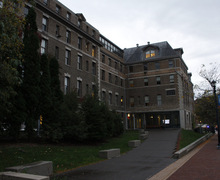Students of SU’s Food Recovery Network donate leftover food to local residents
Courtesy Ivan Shen
The Food Recovery Network prioritizes Graham, Ernie Davis and Sadler dining halls in its food collection, which typically produce an average of 130 pounds of leftover food per day.
Get the latest Syracuse news delivered right to your inbox.
Subscribe to our newsletter here.
When Syracuse University’s dining halls close down for the night, Elliot Salas’ shift is just beginning.
Several weeks ago, Salas became the new president of the Food Recovery Network, a group of SU and SUNY-ESF students that transport leftover food from SU dining halls to low-income communities across Syracuse.
The FRN is a national organization across college and university campuses around the United States, with SU’s chapter becoming one of the largest of the student-led movement to fight food waste and end hunger.
FRN’s main purpose is to limit food waste at SU and SUNY-ESF while directly engaging with local nonprofit organizations, churches, parishes, food pantries and other social work groups to combat poverty and food insecurity in the city of Syracuse, according to an SU News release.
Salas, a sophomore in the College of Engineering and Computer Science, said his time at FRN has felt like self-discovery. He has gained a new perspective about the world around him since joining the organization, he said.
“I used to be a Food Service worker at the Graham Dining Hall,” Salas said. “Workers would throw out food into these red bins, never to be seen again. I was confused why we had to do this and I was looking for a club to help solve this sort of situation.”
Salas said the relationship between SU’s dining halls and FRN is strong, allowing for efficient work and communication between both parties.
“We let the dining halls know we want a food recovery that night, and they’ll save some food,” Salas said. “We go as a group, pack up the food, weigh it, list what’s being recovered, and drive it to food agencies here in Syracuse.”
As Salas is transitioning into his role as President of FRN, he said the future of the organization is bright. He said his next priorities as president include adding more members, spreading awareness about the organization across campus and purchasing their own truck for deliveries.
Adrienn Virag, a third-year architecture student and the previous president of FRN, said one of the organization’s biggest accomplishments this year has been reaching out and working closely with a diverse network of local organizations, such as the Chadwick Residence and the Saints Peter and Paul Church.
Salas said these groups can request FRN’s help on a first come, first serve basis. The organizations request food for a specific day, and if for some reason that day has been claimed by another group, the group will be queued by FRN for the following week. According to Salas, these local organizations usually reach out to FRN, but FRN will step in to help an organization if it is in desperate need.
“We are working with nine organizations right now, seven of which run hot food lines,” Virag said. “We’ve also started working with Greek life and other student-led organizations here at SU.”
Virag says she’s hoping FRN can work with these organizations to help pack, weigh, and drive food to local food pantries and the food agencies they work with.
According to data provided by Salas to The Daily Orange, over 8,500 pounds of dining hall food was preserved, boxed, weighed and sent to food distribution agencies across the Syracuse community during the spring 2022 semester.
Graham Dining Hall alone made up more than 40% of all leftover food collected by FRN, according to the data. Salas said FRN operates consistently at all five dining halls on SU’s campus, with some operations happening on SUNY-ESF’s campus if facilities request collections.

Megan Thompson | Digital Design Director
Virag said FRN tries to prioritize collections from the Graham, Ernie and Sadler dining halls due to their popularity among the SU community. Virag said the Graham, Ernie Davis, and Sadler dining halls typically produce an average of 130 pounds worth of leftover food per day.
“Dining halls have to overproduce because of the volume of students,” Virag said. “They have to have enough food. Some dining halls are better at repurposing (waste). We are very appreciative of their efforts to cut down food waste.”
Allison Schwartz, a third-year architecture student and the social media and outreach coordinator during the spring 2022 semester for FRN, has reached out to more agencies in the local community to expand FRN’s network. Schwartz said she wants, more than anything, to build a strong relationship between SU and the city of Syracuse.
“We’re focusing on building community and a sense of citizenship with students,” Schwartz said. “There’s this issue of food being thrown out of the dining hall and food insecurity at SU, and we do have the capacity to cover every dining hall every day of the week. We are working to prevent these kinds of issues.”
Schwartz said FRN has received tremendous support from all the dining halls on campus, with both parties building a close relationship starting in the fall 2021 semester. Schwartz says she’s worked directly with SU for advertising and outreach, adding that there’s also lots of support coming from the university.
Lauren McNamara, a Maxwell graduate student and the treasurer for FRN this past semester, said she has seen an emotional connection between FRN and dining hall staff over food waste on campus.
“I’ve had a lot of conversations with dining hall staff. They all say they get very sad when they see food go to waste,” McNamara said.
McNamara began working for FRN in 2018. She said she’s seen immense growth during her time with the organization and its expansion has been crucial to better serving the needs of the local community.
She said food insecurity and food waste are still major issues at SU that need to be addressed. McNamara hopes FRN can continue working with other student groups to increase the number of volunteers willing to help and spread awareness about FRN.
David Bruen, who was recently reelected as president of the Student Association, said FRN’s work has not been overlooked, and some members of SA are currently serving as volunteers for the organization.
“Our efforts are intertwined,” Bruen said. “We are in a food desert, and we are providing ways to get around that.”
Published on May 12, 2022 at 3:05 am
Contact Dominic: dcchiapp@syr.edu | @DominicChiappo2






